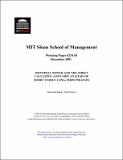| dc.description.abstract | This article develops a multi-period production model to examine the optimal dynamic
behaviour of a large monopolistic value-maximizing firm that manipulates its valuation
as well as the price of its output. In the pre-commitment equilibrium the firm's output
and labour demand are decreased, while the price of consumption is increased, as
compared with its competitive counterpart. Profits and the firm's value can, however,
be either increased or decreased. In the time-consistent equilibrium the firm's output
and labour demand are increased, while the price of consumption is decreased. More
strikingly, the profits in every period are decreased, and may even go negative, while
the firm's value can be either lower or higher than in the competitive benchmark. In the
continuous-time limit, while the pre-commitment equilibrium retains its basic
discrete-time structure, the time-consistent equilibrium tends to the limit of zero profits
and hence zero firm's valu | en |
